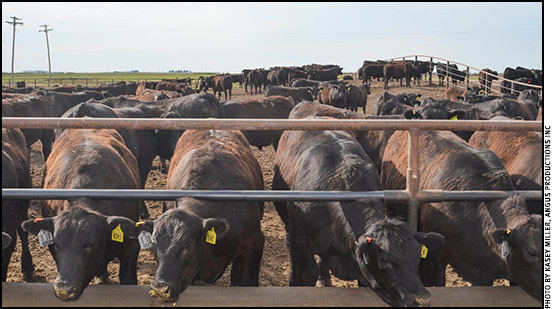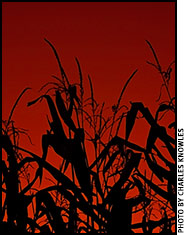HEALTH & NUTRITION...

Benefits of Stocker Supplementation
Depend on When You Sell Them
Researchers look at effects of distillers’ dried grains on stocker and finishing performance, carcass merit.
Steers initially averaging 416 pounds (lb.) in the first year of the study (2007) or 458 lb. in the second year (2008) were grazed on Texas High Plains wheat pasture, stocked at slightly more than one acre per head, with the following treatments:
- distillers’ dried grains (SDDG) at 0.5% of body weight (about 2.7 lb. per day),
- dry-rolled corn (SDRC) at 0.5% of body weight (about 2.7 lb. per day), or
- nonsupplemented controls (SCON).
All groups gained exceptionally well on wheat. The SDDG group gained 3.08 lb. per day, significantly more than either the SDRC group (2.88 lb. per day) or the SCON group (2.84 lb. per day). However, even the SDDG group used supplement inefficiently, requiring 11.5 lb. supplement per 1 lb. added gain. Read more.
Johne’s Disease
What we learned from Ohio demonstration herds.
When the USDA provided funding for states to participate in the National Johne’s Disease Demonstration Herd Project in 2003, William Shulaw, Ohio State University beef and sheep extension veterinarian, jumped at the opportunity. After all, the project to evaluate the long-term effectiveness and feasibility of various management-related disease-control measures for Johne’s disease on dairy and beef cattle operations could bring forth valuable findings. Shulaw also knew Ohio would have herds wanting to participate in the project. In the end, Ohio enrolled three herds: one dairy herd and two beef herds.
Click here to read more of this article and to view others in the Fall 2012 Johne’s Disease — Beef newsletter presented by the National Johne’s Disease Education Initiative, a cooperative effort of the National Institute for Animal Agriculture, USDA, Animal & Plant Health Inspection Service and Veterinary Services in association with the National Johne’s Working Group & U.S. Animal Health Association.
Expanding the Cow Herd Can Bring in Problems
Back-to-back drought years and moving cattle enables spread of trichomoniasis to new areas.
The days of trichomoniasis (trich) being known as a western states problem may be coming to an end. With consecutive drought years throughout many of the cow-calf-producing parts of the country, trich is being found in new areas, including states like Iowa and Missouri, and cattlemen are suffering from its impact.
Trichomoniasis is a venereal disease carried by bulls and transferred to healthy cows, resulting in early embryonic death or abortion. Historically, trich was a problem in the western United States, where multiple herds, under multiple management practices, were managed together on public land. When drought hit those areas, cattle moved into states like Texas, Nebraska and South Dakota — and took trichomoniasis with them. Read more.

Rick Rasby
Ridin’ Herd
Using drought corn silage in beef cow diets.
Drought reared its ugly head in a wide area of the United States, and a large portion of the nation's cow herd was located in the drought-stricken area. Low productivity of pasture and rangeland poses many challenges, including how to best manage cattle in these difficult times and source feeds for the winter.
Another challenge, especially in areas where year-round grazing is not an option, is how to economically secure feeds for the time when cows need to be fed harvested forage. In drought conditions, hays and alfalfas that are staples for feeding the cow herd are usually expensive because yield is low and demand is high. Corn silage is a feed not typically fed to beef cows. This year there was a lot of corn silage harvested, especially on dryland corn acres, because corn was not going to make a grain crop. Read more.
Antibiotic Use, Resistance Calls for Collaborative ‘One Health’ Approach
Symposium coordinated by NIAA emphasizes need for collaboration of human, animal and environmental health communities to address issues and find solutions.
The message emerging from the “A One Health Approach to Antimicrobial Use & Resistance: A Dialogue for a Common Purpose” symposium, Nov. 13-15, in Columbus, Ohio, was clear: Antibiotic use and antimicrobial resistance are the responsibility of all communities — human health, animal health and environmental health — and solutions will require collaboration of these health communities.
At the end of the three-day symposium, which was coordinated by the National Institute for Animal Agriculture (NIAA), presenters and participants agreed on numerous points. Read more.
 Mycotoxins and their
Mycotoxins and their
Effects on Cattle
Mycotoxins are naturally occurring compounds produced by fungi growing on plants in the field or during storage periods. Even though toxigenic molds may grow under a given set of environmental conditions, they do not always produce mycotoxins. However, under the right conditions, mycotoxins can be generated fairly rapidly in the field or in storage. Mold identification can provide a direction to test for potential mycotoxins but does not confirm the presence or identification of a mycotoxin. Read more.
Horse Health Alert
Recent drought causes spike in infections among horses in Missouri,
MU equine veterinarian says.
Philip Johnson, a professor of equine medicine and surgery in the University of Missouri (MU) College of Veterinary Medicine, says he has seen a large spike in the number of Missouri horses infected with Corynebacterium pseudotuberculosis, a bacterial infection that can cause painful swelling, abscesses and inflammation in the legs, chests and abdominal cavities.
“Under normal conditions, this disease is uncommon in Missouri,” Johnson says. “However, likely because of the extremely dry weather Missouri has experienced in the last six months, we have seen an abnormally large number of cases pop up throughout the state. The disease is contracted through abrasions in the skin, as well as by bites from flies and ticks.” Read more.
Cattle Diseases: Common Conditions/Terms
Click here for a list of common conditions and terms related to beef cattle diseases, such as anaplasmosis, brucellosis, BVD, E. coli, IBR and others.
[Click here to go to the top of the page.]











